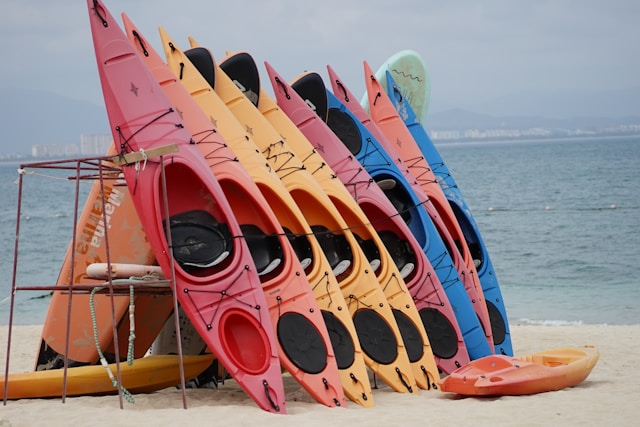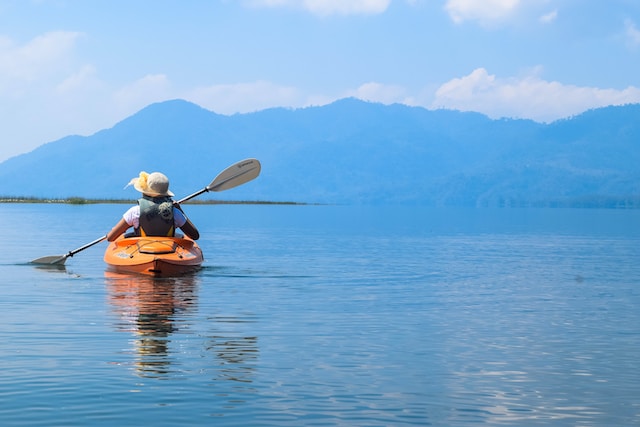What is Kayaking? The Ultimate Guide
What is kayaking? In this ultimate guide to kayaking, we’ll take you on a journey through the captivating world of this thrilling water sport.
From the basics of what kayaking is to detailed explanations of different types of kayaking, we’ve got you covered.
We’ll delve into essential gear and equipment, explore the anatomy of a kayak, and highlight the physical and mental benefits of kayaking.
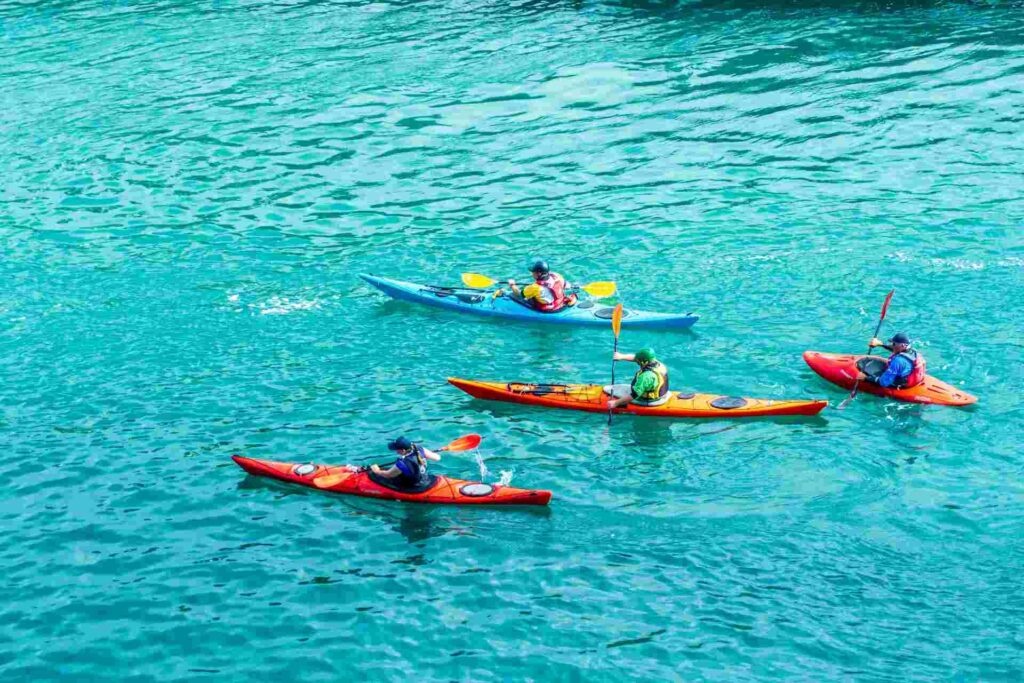
Looking for tips on choosing the right kayak or the best places to go kayaking in the United States?
We’ve got those too! And of course, safety is paramount, so we’ll provide guidelines to ensure you stay safe on the water.
Whether you’re a beginner eager to learn the ropes or a seasoned paddler searching for new skills and adventures, this guide is for you.
So grab your paddle and get ready for an unforgettable journey on the water!
Related:
- WILL YOU GET WET WHILE KAYAKING? – A FRIENDLY GUIDE
- CAN A KAYAK SINK? A COMPREHENSIVE GUIDE
- IMPACT OF WEATHER CONDITIONS ON KAYAK SAFETY
- HOW TO RECOVER FROM A KAYAK CAPSIZE AND RE-ENTER THE KAYAK?
- History of Kayaking
- Types of Kayaking
- Kayak Anatomy
- Essential Kayaking Gear and Equipment
- What is Kayaking?
- The Physical and Mental Benefits of Kayaking
- Choosing the Right Kayak
- Best Places to Go Kayaking in the U.S.
- Kayaking Safety: How to Stay Safe on the Water
- How to Care for and Maintain Your Kayak
- Kayaking Etiquette and Conservation
- Joining the Kayaking Community
- Kayaking Tips for Beginners
- Conclusion
- Frequently Asked Questions
History of Kayaking
Kayaking has a rich history that dates back thousands of years.
It is believed to have originated in the Arctic regions, where indigenous people used kayaks for hunting and transportation.
The first kayaks were made from animal skins stretched over a wooden frame.
Over time, kayaking spread to other parts of the world and evolved into a popular sport and recreational activity. Today, kayaking is enjoyed by millions of people around the globe.
Types of Kayaking
There are different types of kayaking, each offering a unique experience.
Whether you’re a beginner or an experienced paddler, there’s a type of kayaking that suits your interests and skill level.
Let’s explore the three main types of kayaking: recreational kayaking, sea kayaking, and whitewater kayaking.
Recreational Kayaking
Recreational kayaking is the most common type of kayaking and is perfect for beginners and casual paddlers.
It involves exploring calm lakes, ponds, and slow-moving rivers.
This type of kayaking allows you to enjoy the tranquility of nature while engaging in a fun and leisurely activity.
Recreational kayaks are stable and easy to maneuver, making them ideal for relaxing outings on the water.
Sea Kayaking
Sea kayaking takes you into the open sea or coastal waters, offering a completely different experience.
It’s a popular choice for those who want to explore coastlines, islands, and wildlife. Sea kayaks are designed to handle rougher waters and are equipped with features that enhance stability and performance.
This type of kayaking allows you to immerse yourself in the beauty of the ocean and witness marine life up close.
Whitewater Kayaking
For thrill-seekers and experienced paddlers, whitewater kayaking provides an adrenaline-pumping adventure.
It involves navigating fast-moving rivers and challenging rapids. Whitewater kayaks are maneuverable and designed to withstand the powerful currents and obstacles found in whitewater environments.

This type of kayaking requires advanced skills and specialized equipment, such as helmets and spray skirts, to ensure safety.
Whether you prefer the tranquility of calm waters, the vastness of the open sea, or the excitement of challenging rapids, there is a type of kayaking that suits your preferences.
Choose the type that matches your skill level and embark on unforgettable adventures on the water.
Kayak Anatomy
To fully understand kayaking, it is essential to familiarize yourself with the anatomy of a kayak.
Key components include the hull, which is the main body of the kayak; the cockpit, where the paddler sits; the deck, which covers the top of the kayak; and various accessories such as footrests, bulkheads, and hatches.
Understanding the different parts of a kayak will help you make informed decisions when choosing the right kayak for your needs.
Essential Kayaking Gear and Equipment
When it comes to kayaking, having the right gear and equipment is essential for a safe and enjoyable experience on the water.
Personal Floatation Devices
The most important piece of kayaking gear is a personal floatation device (PFD), also known as a life jacket.
A PFD will keep you buoyant in the water in case of an accident or unexpected capsizing.

It’s important to choose a PFD that fits properly and is designed for kayaking to ensure maximum comfort and safety.
Paddles
Kayak paddles are essential for propelling your kayak through the water. They come in a variety of materials, including fiberglass, aluminum, and carbon fiber.
The right paddle for you will depend on factors such as your paddling style, the type of kayaking you plan to do, and your personal preference.
It’s important to choose a paddle that is the appropriate length and weight for your height and strength, as this will greatly impact your paddling efficiency and reduce the risk of fatigue.
Helmets and Safety Kits
Helmets and safety kits are especially important for whitewater kayaking, where the risk of accidents and collisions is higher.
Helmets provide protection for your head in case of impacts with rocks or other objects in fast-moving water.
Safety kits typically include essential items such as a throw bag, a first aid kit, and a whistle, which can be crucial in emergency situations.
Whether you’re planning for a leisurely paddle or an adrenaline-filled whitewater adventure, it’s important to have the necessary safety equipment to ensure your well-being on the water.
What is Kayaking?
In this section, we will cover the basics of kayaking.
We will discuss the different kayak designs, including sit-in and sit-on-top kayaks, and explain the benefits and drawbacks of each.
We will also explore various paddling techniques, such as the forward stroke, sweep stroke, and draw stroke, which are essential for propelling your kayak through the water.
Additionally, we will delve into steering and maneuvering techniques, including edging, ruddering, and bracing, for better control over your kayak.
Kayak Designs
When it comes to kayak designs, there are two main types: sit-in and sit-on-top kayaks.
Sit-in kayaks have an enclosed cockpit where the paddler sits inside the kayak, with their legs and lower body covered.
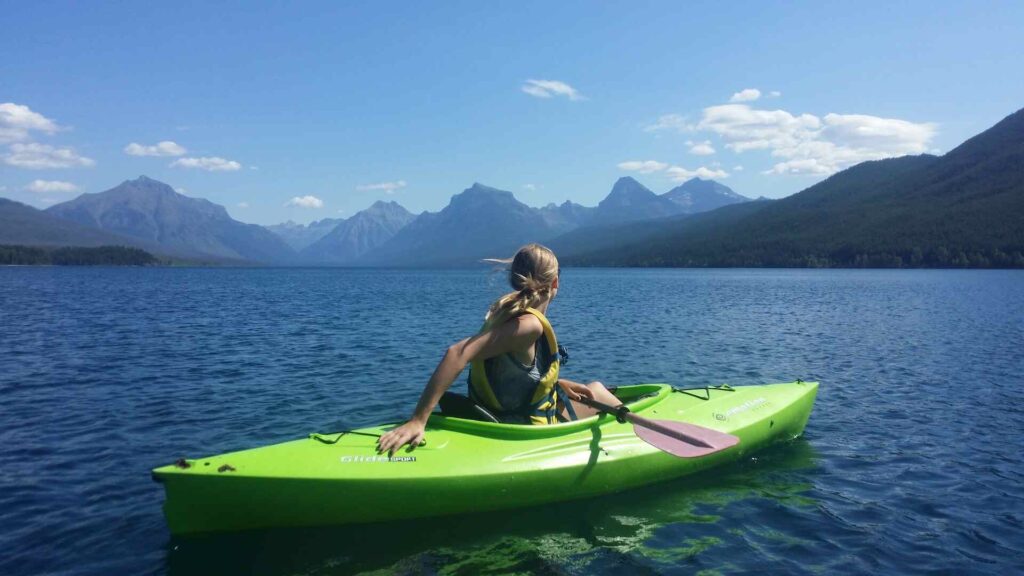
This design provides better protection from the elements and allows for a more efficient paddling technique.
Sit-on-top kayaks, on the other hand, feature an open-top design where the paddler sits on a molded seat or platform on top of the kayak.
This design offers greater stability, ease of entry and exit, and the ability to paddle in shallow waters.
Kayak Propulsion: Paddling Techniques
Mastering the right paddling techniques is crucial for efficient kayak propulsion.
The forward stroke is the basic paddling technique used to move the kayak forward, with the paddle blade entering and exiting the water near the kayak’s feet.
The sweep stroke is used for turning the kayak, with the paddle blade sweeping a wide arc away from the kayak’s hull.
The draw stroke is useful for moving the kayak sideways, with the paddle blade placed perpendicular to the kayak and pulled towards the paddler.
Direction Control: Steering and Maneuvering a Kayak
To effectively steer and maneuver a kayak, various techniques can be employed.
Edging involves tilting the kayak slightly to one side by shifting your body weight, which helps in carving turns and maintaining stability.
Ruddering involves using the paddle as a rudder by placing it in the water and using it to steer the kayak.
Bracing techniques are used to maintain balance and prevent capsizing, with the paddler using their paddle or body to provide support against the water’s resistance.
The Physical and Mental Benefits of Kayaking
Kayaking offers numerous physical and mental benefits that contribute to overall health and well-being.

Building Physical Strength
Regular kayaking is an excellent workout that helps build upper body and core strength.
Paddling engages the muscles in your arms, shoulders, back, and abdominal region, promoting muscle development and toning.
The resistance of the water provides a challenging workout that can lead to increased strength and endurance over time.
Mental Relaxation and Stress Reduction
One of the remarkable aspects of kayaking is the peacefulness and tranquility it provides. Being out on the water surrounded by nature can be incredibly calming and therapeutic.
The rhythmic motion of paddling and the soothing sounds of the water can help reduce stress, promote relaxation, and improve mental well-being.
Kayaking offers a chance to disconnect from the hustle and bustle of everyday life and find tranquility in nature.
Cardiovascular Health
Kayaking is a cardiovascular activity that gets your heart rate up and improves cardiovascular fitness.
Paddling involves repetitive movements that require a continuous supply of oxygen to your muscles.
This aerobic exercise can help strengthen your heart, increase lung capacity, and improve overall cardiovascular health.
Regular kayaking can contribute to a healthier cardiovascular system and lower the risk of heart disease.
Engaging in kayaking provides a holistic approach to health and wellness, benefiting both the body and the mind.
From building physical strength and endurance to experiencing mental relaxation and improving cardiovascular health, kayaking offers a unique and rewarding way to stay active and enjoy the great outdoors.
Choosing the Right Kayak
Factors to Consider
When selecting a kayak, it is important to take several factors into consideration:
- Your kayaking goals: Determine whether you plan to use the kayak for recreational paddling, sea kayaking, or whitewater adventures.
- Your experience level: Consider your skill level and choose a kayak that suits your abilities and provides a comfortable paddling experience.
- Your body type: Take into account your height, weight, and personal preferences to find a kayak that offers a snug and supportive fit.
- Your budget: Set a budget and explore kayak options that fit within your price range. Keep in mind that different kayak materials may impact the cost.
Different Kayak Materials
Kayaks are made from various materials, each with its own advantages and disadvantages:
- Plastic: Plastic kayaks, often made from durable polyethylene, are affordable, resistant to impact, and easy to repair. However, they can be heavier and less responsive on the water.
- Fiberglass: Fiberglass kayaks offer a good balance of weight, performance, and affordability. They are lighter than plastic kayaks and provide better maneuverability, but may be more prone to damage.
- Carbon Fiber: Carbon fiber kayaks are lightweight, strong, and highly responsive. They offer excellent performance and maneuverability on the water. However, they are often more expensive and may require extra care to prevent damage.
Kayak Size and Weight Capacity
Choosing the right kayak size and weight capacity is essential for stability and optimal performance:
- Kayak Size: Consider the length and width of the kayak. Longer kayaks tend to track straighter and cover greater distances, while shorter kayaks offer better maneuverability in tight spaces.
- Weight Capacity: Ensure that the kayak you choose can safely support your weight and any additional gear or equipment you plan to bring on your paddling adventures.
By carefully considering these factors, you can make an informed decision and choose the right kayak that aligns with your needs, abilities, and budget.
Best Places to Go Kayaking in the U.S.
The United States is home to some of the most stunning kayaking destinations in the world.
Whether you prefer serene lakes, rushing rivers, or breathtaking coastlines, there are countless spots for kayaking enthusiasts to explore.

Here, we highlight some of the best kayaking spots in the U.S. that offer unforgettable experiences for paddlers of all skill levels.
- Adirondack Mountains, New York: The Adirondack Mountains offer a picturesque backdrop for kayaking. Explore the calm waters of the region’s numerous lakes, including Lake George and Saranac Lake.
- Glacier Bay National Park, Alaska: Immerse yourself in the awe-inspiring beauty of Glacier Bay National Park. Paddle through icy fjords, marvel at towering glaciers, and spot wildlife such as seals, whales, and eagles.
- Everglades National Park, Florida: Discover the unique ecosystem of the Florida Everglades as you navigate through its mangrove tunnels and expansive marshes. Keep an eye out for alligators, manatees, and a variety of bird species.
- Big Bend National Park, Texas: Explore the remote and rugged beauty of the Rio Grande at Big Bend National Park. Paddle along the river, surrounded by towering canyons and desert landscapes.
- San Juan Islands, Washington: The San Juan Islands offer a kayaker’s paradise with their calm, sheltered waters and stunning vistas. Explore the rocky shorelines, paddle alongside orcas, and soak in the beauty of the Pacific Northwest.
These are just a few examples of the incredible kayaking destinations the United States has to offer.
Whether you’re seeking tranquility, adventure, or the opportunity to connect with nature, kayaking in the U.S. is sure to provide unforgettable experiences.
Kayaking Safety: How to Stay Safe on the Water
Kayaking is a thrilling water sport that offers adventure and excitement.
However, it is important to prioritize safety to ensure a positive and secure kayaking experience.
By following the best practices, understanding weather and water conditions, and knowing how to handle emergencies, you can enhance your safety and enjoyment while kayaking.
Kayaking Best Practices
Adhering to kayaking best practices is essential for maintaining safety on the water.
Always wear a personal floatation device (PFD) or a life jacket and make sure it is properly fitted.
Familiarize yourself with the rules and regulations of the waterway you are kayaking in and respect other boaters and wildlife.
Be aware of your limits and don’t take unnecessary risks. Finally, never kayak alone; it’s always safer to have a buddy or join a group.
Understanding Weather and Water Conditions
Paying attention to weather and water conditions is crucial before heading out for a kayaking adventure.
Check the weather forecast for the day and be aware of any potential storms or wind conditions that may affect your safety.
Additionally, familiarize yourself with the water conditions, such as currents, tides, and waves.
Understand the impact these conditions can have on your kayaking experience and adjust your plans accordingly.
What to Do in an Emergency
While kayaking, it is important to be prepared for emergencies and know how to respond effectively.
If you capsize, stay calm and try to re-enter your kayak or swim to shore if necessary. If you find yourself caught in a strong current, go with the flow and paddle towards the shore at an angle.
In case of injury or assistance needed, be familiar with the emergency procedures and have a plan in place to communicate or call for help.
Always carry a whistle or a communication device for emergencies.
By following these kayaking safety guidelines, you can enjoy the adventure of kayaking while ensuring your personal safety and the safety of others.
Remember, preparation, awareness, and responsible behavior are key to a safe and enjoyable kayaking experience.
How to Care for and Maintain Your Kayak
Proper care and maintenance are essential for keeping your kayak in top condition and ensuring its optimal performance on the water.
By following these tips, you can extend the lifespan of your kayak and prevent potential damage or issues in the future.
Cleaning and Storage
After each kayaking trip, it’s important to clean your kayak properly.
Rinse the kayak with fresh water to remove any dirt, sand, or saltwater that may have accumulated.
Use a mild soap or kayak cleaner to remove stubborn stains or debris. Avoid using harsh chemicals that could potentially damage the kayak’s material.
Once your kayak is clean, make sure to dry it thoroughly both inside and outside.
This helps prevent mold and mildew growth. Store your kayak in a cool, dry place, away from direct sunlight or extreme temperatures.
If possible, hang the kayak or place it on a rack to avoid any deformation or warping.
Kayak Repair and Damage Prevention
Regularly inspect your kayak for any signs of damage or wear.
Look for cracks, scratches, or dents on the hull, cockpit, or deck.
If you notice any damage, it’s important to repair it promptly to prevent further issues.
Minor scratches can be easily repaired using a kayak patch kit or gel coat repair kit.
For more extensive damage, such as cracks or holes, it’s recommended to seek professional repair services or consult the kayak manufacturer for guidance.
To prevent damage to your kayak, avoid dragging it on the ground or other abrasive surfaces.
Be cautious when launching or landing your kayak to avoid hitting rocks or other objects.
Additionally, be mindful of the weight capacity of your kayak and avoid overloading it, as this could strain the hull and compromise its integrity.
Long-Term Kayak Care Tips
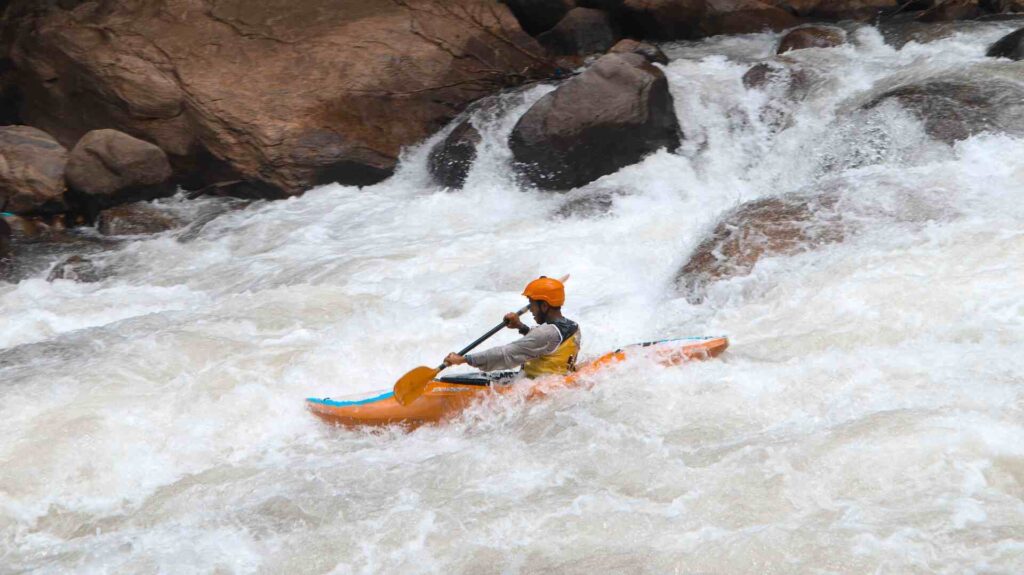
To ensure the long-term care and preservation of your kayak, consider the following tips:
- Regularly inspect and maintain the kayak’s hardware, such as screws, nuts, and bolts. Tighten or replace any loose or rusty hardware to maintain the kayak’s integrity.
- Apply UV protectant to your kayak to prevent fading or damage caused by sunlight exposure. This is particularly important if you store your kayak outdoors or frequently use it in sunny conditions.
- Keep your kayak covered with a protective tarp or kayak cover when not in use. This helps shield it from dust, debris, and UV rays.
- Consider investing in a kayak cart or dolly to safely transport your kayak to and from the water, reducing the risk of damage during transportation.
- Regularly check and maintain the kayak’s safety equipment, such as its personal flotation device (PFD) and safety lines, to ensure they are in good working condition.
By following these care and maintenance tips, you can enjoy your kayak for years to come, knowing that it is in excellent condition and ready for your next paddling adventure.
Kayaking Etiquette and Conservation
As responsible kayakers, it is important to practice proper etiquette and conservation principles.
By following these guidelines, we can ensure the preservation of our waterways and the wildlife that inhabit them. Here are some key aspects to consider:
Respecting Wildlife and the Environment
When kayaking, it is essential to respect the natural habitat and wildlife.
Avoid disturbing wildlife by keeping a safe distance and refraining from pursuing or feeding them.
Take care not to damage vegetation or disturb nesting areas. By being mindful of our actions, we can help maintain the delicate balance of the ecosystem.
Sharing Waterways with Others
Sharing waterways with other watercraft and water enthusiasts requires awareness and courtesy.
Yield to larger vessels and give way to anglers and fishers.
Maintain a safe distance from other kayakers and boaters, and communicate clearly to avoid potential collisions.
By practicing good navigation and communication skills, we can enjoy our kayaking experience while maintaining harmony with others.
Leave No Trace Principles
Adhering to the Leave No Trace principles is crucial for minimizing our impact on the environment. These principles include:
- Plan ahead and prepare: Research and respect any regulations or permits required for your kayaking destination. Be mindful of the potential impact of your activities.
- Travel and camp on durable surfaces: Stick to designated launch points and camping areas to prevent erosion and damage to fragile ecosystems.
- Dispose of waste properly: Pack out all trash and waste, including biodegradable items. Leave the environment cleaner than you found it.
- Minimize campfire impacts: If allowed, use an established fire ring and only burn small, clean-burning wood. Ensure fires are fully extinguished before leaving the area.
- Respect wildlife: Observe animals from a distance and do not approach or feed them. Keep pets on a leash and prevent them from disturbing wildlife.
- Be considerate of other visitors: Respect the solitude and serenity of others by keeping noise levels low and being mindful of their experience.
By adhering to these principles, we can ensure that future generations can also enjoy the wonders of kayaking and the beauty of our natural waterways.
Joining the Kayaking Community
Joining the kayaking community can greatly enhance your kayaking experience and provide a multitude of opportunities for socializing, learning, and exploring new waters.
Whether you’re a beginner or an experienced paddler, being part of a kayaking community offers invaluable resources and connections that can help you take your skills and adventures to the next level.
Finding Local Kayaking Clubs
One of the best ways to connect with the kayaking community is to find local kayaking clubs and organizations in your area.
These clubs often organize group outings, training sessions, and social events where you can meet like-minded kayakers, share experiences, and learn from each other.
They also provide a supportive and welcoming environment for beginners to get started and gain confidence in their kayaking abilities.
Participating in Events and Competitions
If you’re looking for a bit of friendly competition or want to test your skills against other kayakers, participating in kayaking events and competitions is a great option.
These events range from casual races and time trials to more challenging expeditions and freestyle competitions.
Not only do they provide an opportunity to showcase your kayaking talents, but they also offer a chance to meet fellow kayakers who share your passion for the sport.
Online Resources and Forums
In addition to local clubs and events, there are numerous online resources and forums dedicated to the kayaking community.
These platforms are a treasure trove of information, advice, and camaraderie, allowing you to connect with kayakers from all over the world.
Online forums provide a space to ask questions, share tips and tricks, and discuss everything related to kayaking.
You can also find valuable resources such as gear reviews, instructional videos, and trip reports to help you plan your next kayaking adventure.
By joining the kayaking community, you’ll have access to a wealth of knowledge, support, and opportunities for growth in your kayaking journey.
Whether you prefer the tranquility of solo paddling or the excitement of group outings and competitions, being part of a vibrant kayaking community can enrich your love for the sport and open up a whole new world of adventure.
Kayaking Tips for Beginners
Sign Up for a Beginner’s Class
If you’re new to kayaking, signing up for a beginner’s class is an excellent way to learn the proper techniques, safety guidelines, and essential skills.
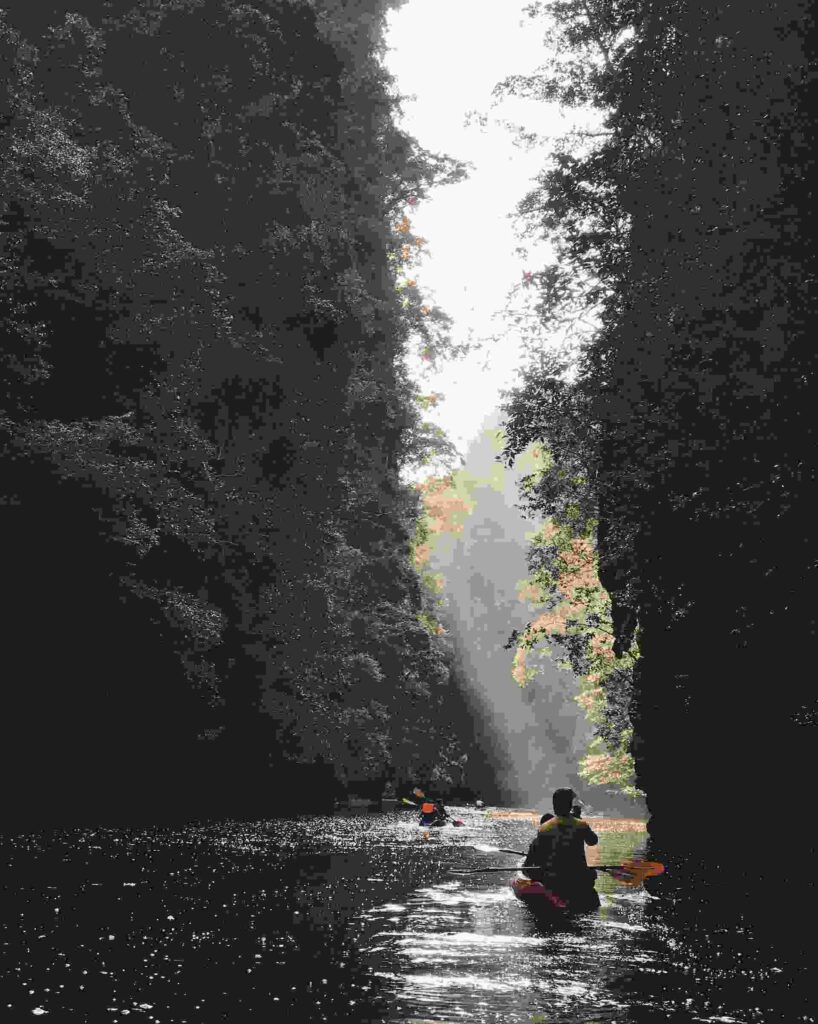
These classes are specifically designed to help beginners get comfortable with kayaking and provide expert guidance in a supportive environment.
Instructors will teach you how to paddle correctly, navigate different water conditions, and handle common challenges you may encounter while kayaking.
By starting with a beginner’s class, you’ll gain the necessary knowledge and confidence to enjoy kayaking to the fullest.
Start with Calm Waters
As a beginner, it’s important to start kayaking in calm waters, such as lakes or slow-moving rivers.
Calm waters provide a controlled environment where you can focus on developing your foundational paddling skills.
These tranquil settings allow you to practice maneuvering your kayak, maintaining balance, and getting comfortable with the motions of paddling.
Starting with calm waters also reduces the risks associated with more challenging conditions, giving you the opportunity to build your confidence and become familiar with kayaking before progressing to more adventurous waters.
Know Your Limits
When starting kayaking, it’s crucial to know and respect your limits. Understanding your current skill level and physical capabilities will help you choose appropriate kayaking experiences that align with your abilities.
Pushing yourself too far beyond your limits can lead to accidents or injuries.
As a beginner, it’s essential to gradually challenge yourself as you gain experience and improve your skills. Always listen to your body, be aware of your surroundings, and make wise decisions about the types of waters and conditions you’re comfortable kayaking in.
By respecting your limits and taking a responsible approach, you’ll be able to enjoy kayaking safely and with peace of mind.
Conclusion
In conclusion, kayaking offers a thrilling and rewarding outdoor experience for individuals of all skill levels.
Whether you are searching for adrenaline-pumping adventures, moments of relaxation, or a deeper connection with nature, kayaking has something to offer.
By adhering to safety guidelines, showing respect for the environment, and continuously expanding your knowledge and abilities, you can create a lifetime of unforgettable kayaking memories.
Remember to always prioritize safety by wearing a personal floatation device, learning proper paddling techniques, and understanding weather and water conditions before heading out on the water.
Additionally, practice good kayaking etiquette by respecting wildlife and other waterway users, and following the Leave No Trace principles to minimize your impact on the environment.
So, grab your paddle, hop in a kayak, and embark on your next thrilling journey on the water.
Whether you choose calm lakes, meandering rivers, or adventurous rapids, the world of kayaking awaits!
Frequently Asked Questions
What is kayaking in simple words?
Kayaking is a recreational water activity where individuals paddle a small boat called a kayak. A kayak is propelled using a double-bladed oar, allowing the paddler to navigate rivers, lakes, or oceans. It offers a thrilling experience, allowing people to explore and enjoy the natural beauty of water bodies. Kayaking can be done individually or in groups and is suitable for both leisurely paddling and adventurous pursuits like whitewater kayaking. It is a popular outdoor activity that provides exercise, relaxation, and opportunities to connect with nature.
What is a kayak used for?
Kayaks are versatile watercraft that serve various purposes. They are primarily used for recreational activities such as paddling in calm waters, exploring lakes, rivers, and coastal areas, or fishing. Kayaks are also popular among outdoor enthusiasts for activities like camping, wildlife observation, and photography. Additionally, kayaks can be used for more adventurous pursuits like whitewater kayaking or sea kayaking for longer expeditions. Some individuals even use kayaks for racing or as a means of transportation in certain regions. Overall, kayaks offer a means of enjoying and connecting with the natural environment while engaging in a range of water-based activities.
Is kayaking an Olympic sport?
Yes, kayaking is an Olympic sport. There are two disciplines of kayaking included in the Olympic Games: flatwater kayaking and slalom kayaking. Flatwater kayaking involves racing on calm waters in straight-line courses, while slalom kayaking involves navigating a challenging whitewater course with gates in the fastest time possible. Both disciplines require skill, technique, and athleticism. Kayaking has been part of the Olympic program since the 1936 Berlin Games for men and since the 1948 London Games for women. It continues to be a competitive and exciting sport that showcases the agility and strength of athletes from around the world.
What is the difference between kayaking and canoeing?
The main difference between kayaking and canoeing lies in the design and paddling technique of the watercraft. In kayaking, individuals sit in a closed cockpit with their legs stretched out in front and use a double-bladed paddle to propel themselves forward. Canoeing, on the other hand, involves individuals sitting or kneeling in an open boat and using a single-bladed paddle. This difference in paddling technique gives kayaks better maneuverability and speed, making them ideal for navigating rapids or coastal waters. Canoes, with their larger size and open design, offer more space for people and cargo, making them popular for recreational activities like fishing or leisurely paddling on calm waters.
Is kayaking very difficult?
The difficulty level of kayaking can vary depending on factors such as the type of water, skill level, and the specific activity or technique being practiced. For beginners, kayaking on calm and flatwater can be relatively easy to learn and enjoyable. Basic strokes and maneuvers can be quickly acquired with some practice. More advanced forms of kayaking, such as whitewater kayaking or sea kayaking in challenging conditions, require additional skills and experience, making them more demanding. It is recommended for beginners to take lessons, practice proper safety measures, and gradually build their skills to tackle more challenging kayaking activities. With proper instruction and practice, kayaking can be an accessible and rewarding outdoor activity for people of various ages and fitness levels.
Does kayaking build muscle?
Yes, kayaking can be a great form of exercise that can help build and tone muscles. The paddling motion engages muscles in the arms, shoulders, and back, helping to strengthen and develop upper body strength. Additionally, the core muscles are engaged as the paddler stabilizes and maintains balance in the kayak. Legs and lower body muscles are also used for stability and bracing against the kayak. Regular kayaking sessions can contribute to muscle development, especially when paddling against currents or in more challenging conditions. However, the intensity and effectiveness of muscle building will vary depending on factors such as duration, intensity of paddling, and individual effort.





